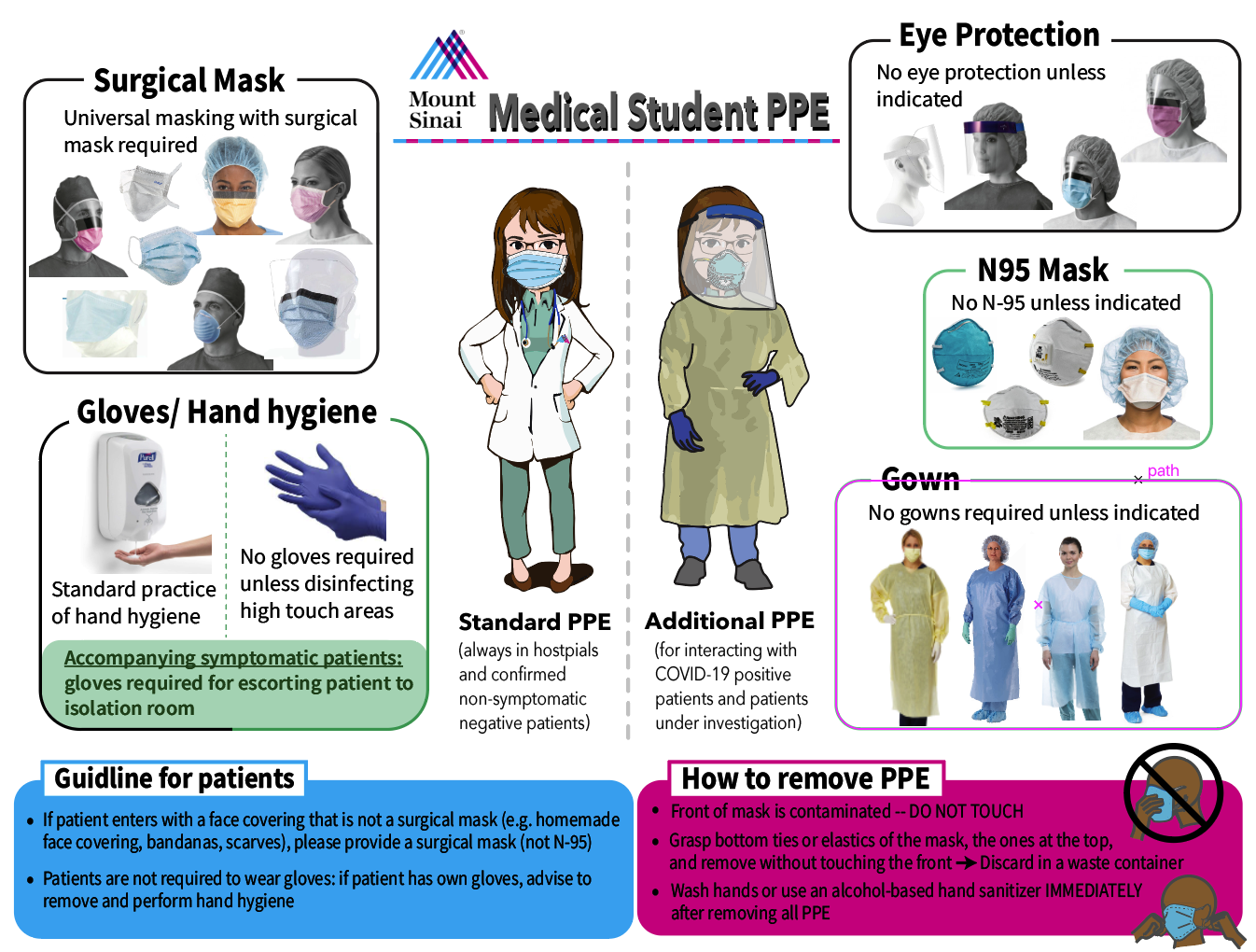Medical students are required to wear surgical masks at all times when on campus for the medical school. You can get a surgical mask at the security desks of the hospital entrances. Additional PPE should be worn when seeing patients as directed.
*All PPE, including masks, used on site should come from the Mount Sinai Health System (please do not use PPE acquired from other sources).
Safety Kit
Safety kits include standard, reusable items for infection prevention.
Each kit includes:
- Plastic box with a sealable lid to store items used in the clinical environment (such as medical equipment or shoes)
- A thermometer
- Personal refillable hand sanitizer
- Face covering
Emergency Kit
Emergency Kits are ONLY for use in the rare situation when a student is at a site and there is no PPE available for a patient interaction that requires PPE. We have received assurance that adequate PPE will be available at all clinical care sites. In case of an emergency, if a PPE item is not available, the Emergency Kit will allow a student to continue their learning experience safely. Each kit includes:
- Face shield
- Isolation gown
- Booties
- Goggles
- N95 mask (Students MUST keep the N95 mask used during their mask fit and include it as part of their Emergency Kit).
These emergency kits MUST be brought by students to their clinical training sites everyday. In the event that a student cannot procure the proper PPE at the clinical site on a specific day, the student will:
- Utilize one or more items from the Emergency Kit
- Report this instance of utilization of items in the Emergency Kit the same day via a Formstack online form (MedInfo app→Y3-4→PPE Break the Glass!)
As a result of submitting a report, the Clinical Curriculum Team will:
- Investigate and review this compliance issue and report to Medical Education leadership for follow-up.
- Replenish a student’s Emergency Kit supplies
- If a student needs to access any PPE items from their emergency kit, they must report this utilization through the above reporting process. Any items used, including the N95 mask, will be replenished as needed once a student has reported.
Students with additional concerns about safety or safety protocols at their clinical training sites, should contact clerkships@mssm.edu.
Student PPE Overview

What kind of PPE should students/staff use?
NOTE: ALWAYS check the patient’s electronic medical record using a computer, iPad mini provided by MedEd or other mobile device and don the proper PPE BEFORE entering the patient room.

Additional Info - COVID-19 Positive Patients and Patients Under Investigation
These patients will be placed under
- Special Droplet Precautions
- Contact Precautions
Required PPE includes:
- N95-respirator
- Gown
- Gloves
- Eye protection (can be a disposable face shield or reusable goggles; glasses alone are inadequate as they do not protect the side of your eyes)
If the patient is in a COVID-19+ Unit or Room with multiple COVID-19+ patients
- Wear the PPE as outlined above
- Change gloves between patients
- Wash hands between patients
- Other PPE DOES NOT have to be changed between patient encounters
If the patient is NOT cohorted in a COVID-19+ unit * Completely don and doff PPE upon each entry and exit of their room.
Additional Info - Confirmed COVID-19 Negative Patients
Surgical Mask*, additional PPE as needed
Students should switch out any personal cloth masks or face coverings for a surgical mask upon entering the hospital and clinic facilities. Surgical masks can be found at the security desks at the hospital entrances.
Additional Info - Aerosolizing Procedures
A Note on Aerosol Generating Procedures: Aerosol generating procedures are high-risk procedures for transmitting viral particles that require the use of an N95 mask when dealing with PUIs or COVID-19 positive patients.
COVID-19 positive patients requiring frequent aerosolizing procedures will be prioritized for airborne isolation rooms. These patients are not required to be in negative pressure rooms.
MGH has compiled a comprehensive list of aerosolizing procedures, which can also be found here:
- Airway surgeries (ENT, thoracic, transsphenoidal)
- Sputum induction and aspirate collection
- Intubation/extubation
- Chest Compressions
- Nebulizers
- Non-invasive positive pressure ventilation (e.g. BIPAP, CPAP)
- High flow oxygen, including a nasal cannula at >15L
- Bronchoscopy
- Tracheostomy
- Open suctioning of tracheostomy or endotracheal tube
- Tracheostomy change
- Chest physiotherapy
- Bronchiolar lavage
- Mechanical ventilation (e.g. bag-mask ventilation prior to intubation)
- Disconnecting patient from ventilator
- Ventilator circuit manipulation
- Upper Endoscopy (including transesophageal echocardiogram)
- Lower Endoscopy
- Venturi mask with cool aerosol humidification
- Mechanical In-Exsufflator
Swab testing is not considered aerosolizing and therefore does not require an N95
Be mindful of PPE rules of the specific department or unit you are working in, which may be slightly more stringent than the above.